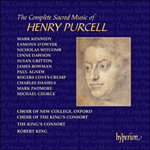The Lord is my light dates probably from 1683/84, the middle of the period in which Purcell wrote many of his verse anthems with string accompaniment. Two autographs survive: an early, rough copy now in Birmingham’s Barber Institute (MS 5001), and a fair copy, also in Purcell’s hand, in the famous ‘Royal Manuscript’, the volume into which Purcell copied many of his early sacred works.
The two-section Symphony is a fine one, the slow opening once again demonstrating the composer’s deliciously wistful writing in the most ravishing harmony: the more lively triple-time second section dances in overt joy, but not far beneath the surface, as with so much of Purcell’s string writing in the anthems, lies the melancholy that makes his music so unique. The soloists’ first entries overlap the end of the Symphony, graceful both in the French rhythms that had influenced the writings of many leading British composers, but also in the daring melodic lines that are so very English. Short instrumental ritornelli preface and close the more dramatic bass solo ‘Though an host of men were laid against me’ before the trio of voices return at ‘For in the time of trouble’. Here Purcell’s vocal writing is at its most daring, with chromaticism falling and rising to colour ‘trouble’ and the immovable ‘rock of stone’ illustrated with long tied notes: as a conclusion the strings are instructed to play ‘the Triple of the Symph. again’. ‘And now shall he lift up mine head’ is scored for a solo tenor; the word ‘round’ is treated to three elegant melismas before the strings close the section with another fine instrumental ritornello. The trio return for ‘Therefore will I offer in his dwelling’, joyful in their ‘great gladness’ before embarking on an extended series of Alleluias. Once again their varied material is taken up by the strings before the full choir, in more legato vein, closes a fine anthem.
from notes by Robert King ©
The Lord is my light (
Le Seigneur est ma lumière) date probablement de 1683/84, vers le milieu de la période pendant laquelle Purcell composa beaucoup de ses ‘anthems’ avec accompagnement d'instruments à cordes. La symphonie en deux sections est très belle et son ouverture lente est un exemple du style délicieusement mélancolique du compositeur avec de merveilleuses harmonies: la deuxième section à trois temps plus animée semble danser de joie, mais, comme si souvent dans l'écriture pour les cordes des anthems de Purcell, on décèle la mélancolie sous-jacente qui caractérise sa musique. Les premières entrées des solistes chevauchent la fin de la symphonie, gracieuses à la fois dans les rythmes français qui avaient influencé le style de tant de grands compositeurs britanniques, mais aussi dans les lignes mélodiques hardies qui sont typiquement anglaises. De courtes ritournelles instrumentales introduisent et terminent le solo plus dramatique de la basse ‘Though an host of men were laid against me’ (Même si une armée d'hommes me menaçait) avant le retour du trio de voix à ‘For in time of trouble’ (Car dans les moments difficiles). C'est là que l'écriture vocale de Purcell est particulièrement hardie, avec un chromatisme ascendant et descendant pour exprimer ‘trouble’ et l'immuable ‘rock of stone’ (rocher de pierre) illustré par de longues notes liées: en conclusion les cordes sont priées de jouer ‘de nouveau la partie ternaire de la symphonie’. ‘And now shall he lift up my head’ (Et maintenant, il me fera relever la tête) est écrit pour ténor solo; le mot ‘round’ est orné de trois élégants mélismes avant la conclusion de la section par une belle ritournelle des cordes. Le trio revient avec ‘Therefore will I offer in his dwelling’ (Je ferai donc des offrandes dans sa demeure), se réjouissant de sa ‘grande joie’ avant de se lancer dans une série prolongée d'Alléluias. Cette fois encore, son matériel sonore varié est repris par les cordes, puis le choeur entier, dans un style plus legato, termine ce bel anthem.
extrait des notes rédigées par Robert King © 1994
Français: Madeleine Jay
The Lord is my light stammt wahrscheinlich von 1683/84, aus der Mitte der Zeit, in der Purcell viele seiner Verse-Anthems mit Streicherbegleitung schrieb. Die feine zweiteilige Sinfonie mit der langsamen Einleitung verdeutlicht in bezaubernder Harmonie wieder einmal die wunderschöne, wehmütige Kompositionsweise des Komponisten – der lebhaftere zweite Teil im Tripeltakt tänzelt mit offensichtlicher Freude daher, aber nicht tief unter der Oberfläche liegt wie so oft in Purcells Streicherpartien seiner Anthems eine Melancholie, die seine Musik so einzigartig macht. Die ersten Einsätze der Solisten überlappen sich am Ende der Sinfonie, sie sind nicht nur anmutig in den französischen Rhythmen, die einen großen Einfluß auf das Werk vieler führender Komponisten Englands besaßen, sondern auch in den gewagten, typisch englischen, melodischen Linien. Das dramatische Baßsolo ‘Though an host of men were laid against me’ [Und steht wider mich ein Kriegsheer] wird von kurzen Instrumental-Ritornelli eingeleitet und abgeschlossen, bevor alle drei Stimmen mit ‘For in the time of trouble’ [Am Tag des Unheils] wieder einsetzen. Hier ist die Vokalkomposition Purcells am gewagtesten – zur Färbung von ‘trouble’ [Unheil] fällt und steigt die Chromatik und der sichere ‘rock of stone’ [Felsen] wird durch lange gebundene Noten illustriert. Als Abschluß erhalten die Streicher die Anweisung, ‘den Tripel der Sinfonie wieder zu spielen’. ‘And now shall he lift my head’ [So darf ich nun erheben mein Haupt] ist für Tenorsolo geschrieben; das Wort ‘round’ [umringen] erhält drei elegante Melismen, bevor der Satz durch ein weiteres Instrumental-Ritornello der Streicher abgeschlossen wird. Das Stimmentrio kehrt ‘in ihrer großen Freude jubelnd’ für ‘Therefore will I offer in his dwelling’ [In seinem Zelte weihe ich Opfer] wieder und beginnt dann eine längere Alleluja-Reihe. Wiederum wird ihr unterschiedliches Material von den Streichern aufgenommen, und mit vollem Chor – hier mehr legato – schließt ein feines Anthem ab.
aus dem Begleittext von Robert King © 1994
Deutsch: Meckie Hellary


 Purcell: The Complete Sacred Music
Purcell: The Complete Sacred Music
